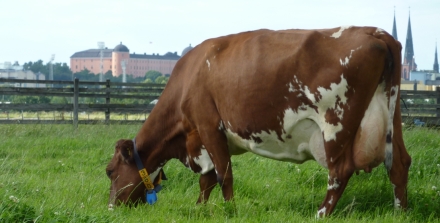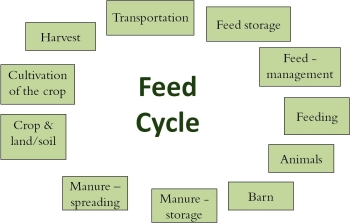Feed Cycle
An interdisciplinary research project about the environmental influence of feed. The aim of this project was to build a network of compentences from all parts of the chain, and to identify critical knowledge gaps in the cycle of home grown or locally produced feed.
Background
Animal production is a large part of Swedish agriculture. 75 % of the cropland is used for feed production. The animals impact on the environment is a question that has got a lot of attention these days and the demand is high to reduce the losses of nitrogen, phosphorus and green house gases from animal production. All environmental impact from the animals depend on how the feed is produced and how the animals can utilise the feed. Some parts of the feed production chain is well understood and analysed in defined research projects, but other parts of the chain and especially the relationships between the different parts and how they interact with each other need to be further investigated.

(Photographer: Jan Olofsson)
General goal
To contribute to an environmentally friendly animal production by reducing nutrient losses in all parts of the feed chain
Aim
The aim of this project was to build a network of compentences from all parts of the chain, and to identify critical knowledge gaps in the cycle of home grown or locally produced feed. We will make preparations so that we later in this process can create an interdisciplinary system analysis model that can simulate the flow of carbon, nitrogen, phosphorus and dry matter on farm level, primarily in dairy and beef production.
Project goal
To coordinate applications and canalize research initiatives and PhD projects to key areas that have been identified in this project.
Scope
We will monitor all steps in the production of feed from cultivation on the field, through the animal, manure storage and spreading of the manure to the crop with a simulation model. The model will give an overview of the environmental impact of the feed and the model will be a central part of future research activities. The model will simulate quantities and specify in which forms the different nutrients circulate in the feed chain. The first step was to monitor the cycle of forage production on a dairy farm during one year.
Contact
For more information, contact Torsten Eriksson, torsten.eriksson@slu.se or Margareta Emanuelson, margareta.emanuelson@slu.se

Figure 1. Graphic model of the feed cycle and its different areas
Links
A collaboration between:
- Department of Energy and Technology
- Dep. of Animal Environment and Health
- Dep. of Animal Nutrition and Management
- Dep. of Rural Building and Animal Husbandry
- Dep. of Soil and Environment
- Dep. of Agricultural Research for Northern Sweden
- Dep. of Aquatic Sciences and Assessment
- JTI - Swedish Institute of Agricultural and Environmental Engineering
- SIK - the Swedish Institute for Food and Biotechnology
Brochure
Brochure about the Feed Cycle project (3,7 Mb)